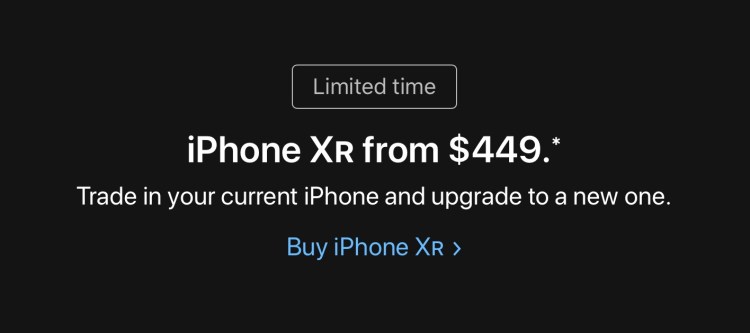The signs of an iPhone sales slowdown were there if you knew to look for them, including reports of production cuts, unexpectedly fast price drops in Japan, and boosts to Apple’s trade-in values for old iPhones. Now Bloomberg explains what’s going on behind the scenes: Apple has reallocated staff in a “fire drill” to spark sales of the latest iPhones, which are apparently requiring extra marketing and discounting efforts during the 2018 holiday season.
According to the report, Apple moved marketing personnel from other projects to “help goose” purchases of the iPhone, the company’s largest revenue generator. As a result, the company is now employing aggressive promotions that haven’t been seen in years, most conspicuously including a front page Apple.com banner offering the month-old iPhone XR for only $449 with an eligible trade-in. (The deal assumes you’re willing to give up an iPhone 7 Plus in good condition.)
In past years, Apple has been famously reluctant to publicly discount its products, instead offering only token incentives, such as free headphones or stingy gift cards on shopping holidays. But the company’s own promotions have been more aggressive this year, starting with higher gift card values over the Black Friday weekend and continuing yesterday with the announcement of a flat 10 percent discount for active military personnel and veterans. Though the latter promotion evened out a previously variable 5 to 15 percent discount for service members, it added Apple devices that were not previously eligible for deals, casting a special spotlight on cut-price iPhones, iPads, and Macs.
Though the Bloomberg report delicately calls the latest marketing moves a “possible admission that the devices may have been selling below some expectations,” it’s clear Apple wouldn’t have started promoting discounts if sales were already on track to meet expectations. Yet claims of iPhone sales troubles clearly didn’t sit well with Apple over the last year, beginning with 2017’s iPhone X — the first Apple smartphone to start at a $999 price point. In quarterly conference calls with analysts, Apple repeatedly rebuffed reports of component order cuts and manufacturing slowdowns by stating that the iPhone X was its top-selling device. It underscored its confidence by releasing 2018’s iPhone XS at the same $999 entry price, with the larger iPhone XS Max starting at $1,099.
June 5th: The AI Audit in NYC
Join us next week in NYC to engage with top executive leaders, delving into strategies for auditing AI models to ensure fairness, optimal performance, and ethical compliance across diverse organizations. Secure your attendance for this exclusive invite-only event.
But the XS models don’t appear to be enjoying the same success as their predecessor. In an atypical disclosure last week, a senior Apple marketing executive said that the less expensive iPhone XR has been the company’s best seller since it was released in late October. While this wasn’t unexpected, in the sense that many reviewers recommended the XR over the XS, it came amidst a freefall in Apple’s once soaring stock — triggered by the company’s decision to stop disclosing iPhone unit sales.
Apple’s statement appeared to be counterbalancing reports that the company was working with Japanese carriers to lower the XR’s monthly cost, following complaints that its $749 price was too high, even spread across multiple payments. Consumers in other large smartphone markets, notably including China and India, have similarly balked at Apple’s latest prices.
iPhone unit sales have flattened out in recent years, leaving Apple with three clear options to increase revenues: raise prices and hope to sell at least as many units, drop prices and sell more units, or find something new to generate more money. While Apple’s services business is growing at a brisk pace and the company is expected to launch a streaming video service in 2019, future products — including 5G iPhones and a rumored augmented reality headset — appear to be at least a year and a half away. In the meantime, users are clamoring for more affordable Apple devices, and discounting is the easiest way to make that happen.

